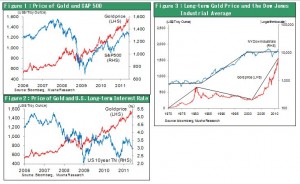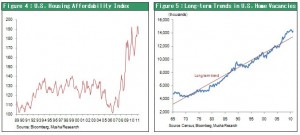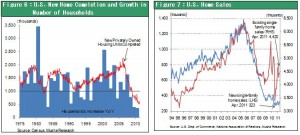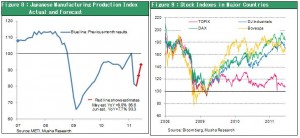A “win-win” environment for investments
The weak U.S. economic recovery that Fed Chairman Ben Bernanke calls “frustratingly slow” has led to a stock price correction stating since May. The drop of stock prices is not as sharp as the one of last year led by Greek debt crisis. Nevertheless, U.S. stock indexes have fallen for six consecutive weeks, the longest bear market since 2002. However, the current U.S. economic slowdown may be only temporary and followed by faster growth in the second half of 2011. Investors should probably expect this correction to end after a few more weeks. But if the recovery fails to regain momentum, we could see measures like QE3 or more tax cuts (additional tax credits for new jobs are under consideration). Even if this happens, we will probably see stock prices start to climb again. I believe there is a 70% chance that this U.S. economic slowdown is only a temporary event.
The gold market rally may be the proof of confidence in the Fed
The prolonged upturn in gold prices is a clear sign that investors have absolute faith in the Fed. Investors’ belief that that the Fed’s monetary easing will produce a sustained stock market rally and economic growth is reflected in the continuing gold price rally. Since February 2011, stock prices have weakened steadily as long-term interest rates fell. During this same period, though, gold alone has staged a consistent rally. More costly gold is clearly not a sign of upcoming inflation because long-term interest rates are falling and prices of other commodities (crude oil, copper and other resources) are decreasing. Gold is becoming more valuable precisely because of the belief that the Fed can override fears of deflation that are appearing in economic fundamentals (case 1 in the figure below). That means we can expect to see stock prices continue to climb as long as the gold market rally lasts. Over the past five years, the only steep drop in the price of gold occurred in 2008 amid mounting worries about deflation. Gold lost value at that time because of uncertainty about the Fed’s ability to prevent deflation (case 4 in the figure below).
Gold Price Matrix
<Higher gold price>
1) Poor economic growth ⇒ Falling long-term interest rates ⇒ Monetary easing by the Fed ⇒ Stock market rally ;Worries about deflation but confidence in monetary authorities
2) Economic growth ⇒ Rising long-term interest rates ⇒ Stock market rally
; Increasing expectations for inflation
<Lower gold price>
3) Economic growth ⇒ Rising long-term interest rates ⇒ Monetary tightening by the Fed ⇒ Stock market rally ;Worries about monetary tightening in response to high rate of inflation
4) Recession ⇒ Falling long-term interest rates ⇒ Doubts about effectiveness of the Fed ⇒ Falling stock prices ;Worries about the inability to prevent deflation

Is the strongest gold rally in 30 years the precursor of a prolonged stock market rally?
All these points lead to the conclusion that the price of gold is still a leading indicator for U.S. stock prices and the economy. We will probably see events progress as shown in Figures 1 to 3 below. First, the price of gold will increase even during economic stagnation if investors believe the Fed’s additional monetary easing can offset this weakness (Figure 1). This is what is happening right now. Next, the price of gold will still increase if steady economic growth fuels growing expectations of inflation (Figure 2). But the price of gold will drop if there is a switch to significant monetary tightening in response to an overheating economy (Figure 3). Even in this case, though, stock prices will most likely continue to climb.
From a longer-term perspective as well, there is a strong possibility that the price of gold has been an indicator of upcoming changes in the real economy. As you can see in Figure 3, the powerful surge in the price of gold in 1980 was the starting point of an upturn in stock prices that spanned two decades. Growth in purchasing power associated with the big increase in the price of gold fueled long-term economic expansion. I will discuss this subject further at another time. But my assumption is that the current gold market rally, which is the strongest in 30 years, is a sign of upcoming economic growth and higher stock prices.
The U.S. economic slowdown will end soon
A number of negative events that occurred in the first half of 2011 caused the U.S. economic growth rate to decline. Economic growth was held back by supply chain disruptions resulting from Japan’s catastrophic earthquake, cuts in government spending (especially state and municipal budgets and defense spending), the higher cost of crude oil, problems caused by unfavorable weather, and other events. But all of these negative factors are one-time events. With these events now behind us, we will probably see economic growth in the second half of 2011. In addition, signs are emerging that the housing market has hit bottom. On June 9, the Financial Times reported that U.S. housing prices increased (in 24 of 26 major U.S. cities) for the first time since the end of first time homebuyer tax credits in April 2010. Moreover, the number of people purchasing houses is beginning to climb. In San Diego, a real estate agent stated that entry-level homes in the $200,000 to $300,000 range are selling because they have become very affordable. Changes in individual dispersed demand begin with encouraging signs like this one. All the pieces are falling into place for reaching a bottom of the U.S. housing market. For example, home prices have become extremely undervalued in relation to affordability (Figure 4). There were 14.2 million vacant homes at the end of March 2011 in relation to the total of 130 million homes in the United States. This is one million units above the normal trend. However, this excess should be quickly eliminated by the average annual growth rate of about one million households, and the current drop in annual new housing construction to 500,000 units and for other reasons (Figure 6).


An excellent opportunity to buy Japanese stocks
Earthquake recovery activities in Japan are progressing rapidly as expected. Production in Japan is almost certain to return to the level prior to this disaster by autumn. Significant demand associated with reconstruction will probably start to emerge in August and September once the Japanese government finalizes the second supplementary budget. Furthermore, Japan is moving quickly to supply emergency liquidity. Reflation measures by the government would be minor under normal circumstances. But following this disaster, the government is likely to embark on a full-scale reflation program. Despite the outlook for rapid economic rebound in Japan, valuations of Japanese stocks are at an unprecedented low. About 60% of TSE listed stocks have a PBR of less than one. Additionally, the impending resignation of Prime Minister Kan is good news because the new leadership will accelerate the pace of earthquake reconstruction activities. Tax-hike plans are a source of concern and so is the half hearted stance of the Bank of Japan. But these concerns are unlikely to give investors new reasons to sell Japanese stocks at their current extremely undervalued prices. Consequently, if a summer stock market rally on a global scale begins in July, there is a very high probability that Japanese stocks will play a central role in this rally.






